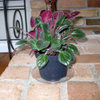Gloxinia
smithjm
18 years ago
Related Stories

BATHROOM COLOR8 Ways to Spruce Up an Older Bathroom (Without Remodeling)
Mint tiles got you feeling blue? Don’t demolish — distract the eye by updating small details
Full StoryI found this little beuty at walmart today. It has at least 15 buds under those big leaves! Is the first time i've owned one of these, so I hope I have luck with it. It didn't come with a tag, just a ticket that said gloxinia. I was searching online and found some good info on it. Does anyone know what type of gloxinia it is? they had pink and light pink but i thought the purple was more striking.
Here is a link that might be useful: http://community.webshots.com/photo/357680679/421556522oJMrsQ#


greenelbows1
smithjmOriginal Author
Related Professionals
Allentown Landscape Architects & Landscape Designers · Alexandria Landscape Contractors · Golden Gate Landscape Contractors · Goodlettsville Landscape Contractors · Huntley Landscape Contractors · Lewisville Landscape Contractors · Palos Verdes Estates Landscape Contractors · Panama City Beach Landscape Contractors · Porterville Landscape Contractors · Maplewood Landscape Contractors · Annapolis Siding & Exteriors · Cypress Siding & Exteriors · Denton Siding & Exteriors · Southampton Siding & Exteriors · Tigard Siding & Exteriorsjon_d
smithjmOriginal Author
JohnnieB
jon_d
jon_d
edawes
irina_co